This post contains affiliate links.
Welcome to the enchanting world of California hummingbirds! This Golden State is a paradise haven for hummingbird enthusiasts. Whether gazing through binoculars or listening intently in a garden, you will be captivated by the vibrant imagery and melodious sounds of these aerial acrobats.
I am extremely lucky to be able to see my hummingbirds up close; as close as one foot in front of my face as my hummingbirds anxiously await my return with their near-empty feeder with a full new feeder.
They fly up to the feeder, perch, and start drinking the nectar even before I get the feeder hung up for them.
They definitely know me and are not at all afraid of me.
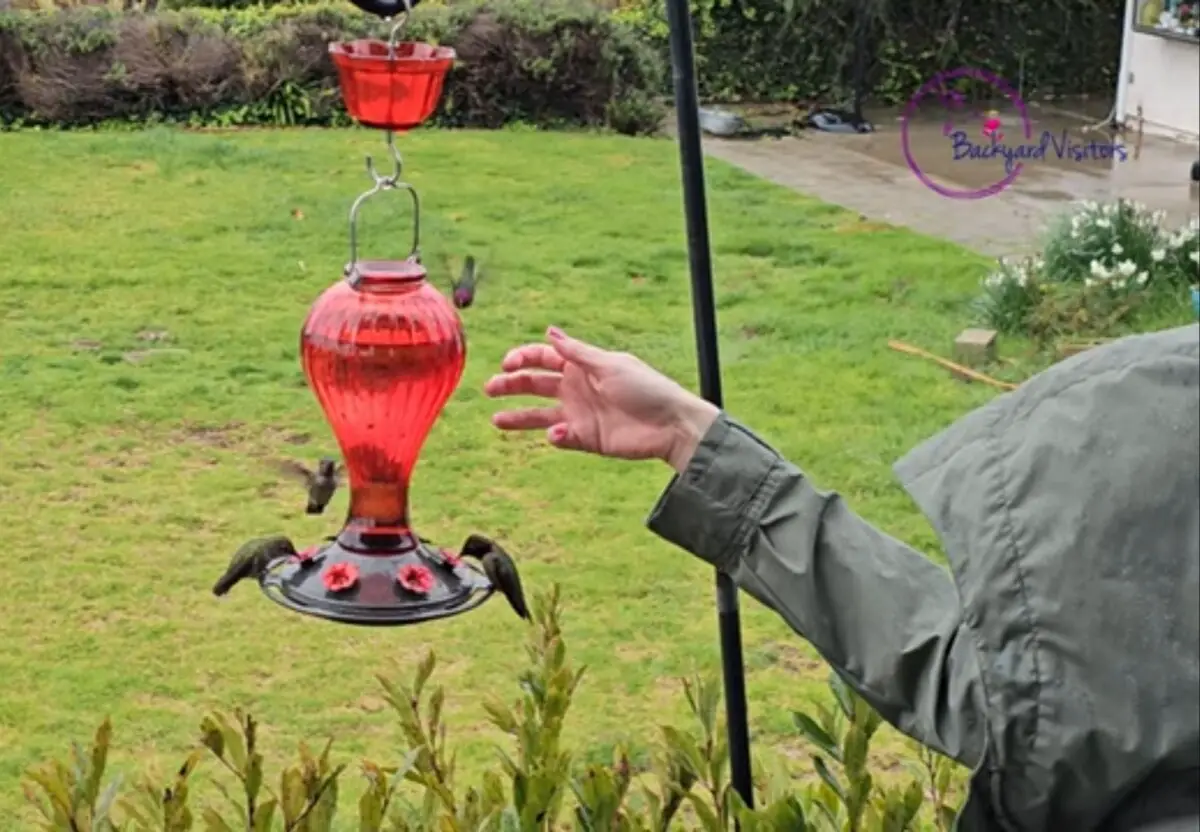
My article takes you on a journey through the diverse species of California hummingbirds, complete with striking pictures and the charming symphony they compose that fills the air. Prepare to be mesmerized by the beauty and wonder of California’s hummingbirds.
Welcome to the Diverse World of California Hummingbirds
The enchanting hummingbirds found in California, which grace us with their iridescent feathers and swift flight are a marvel to be seen. This Golden State plays host to a remarkable variety of these tiny avian wonders, each species adding a splash of color and vibrancy to our backyards and wild spaces.
From the oak-studded hillsides to the sun-kissed coastal gardens, California’s landscape is a patchwork quilt of habitats that accommodate various hummingbird species. Imagine witnessing the heartwarming sight of an Anna’s hummingbird, with its dazzlingly red gorget or throat and emerald green back, hovering skillfully amid the bouquet of a flowering aloe. Or perhaps the Allen’s hummingbird, flashing coppery-orange hues as it flits with acrobatic prowess from bloom to bloom.
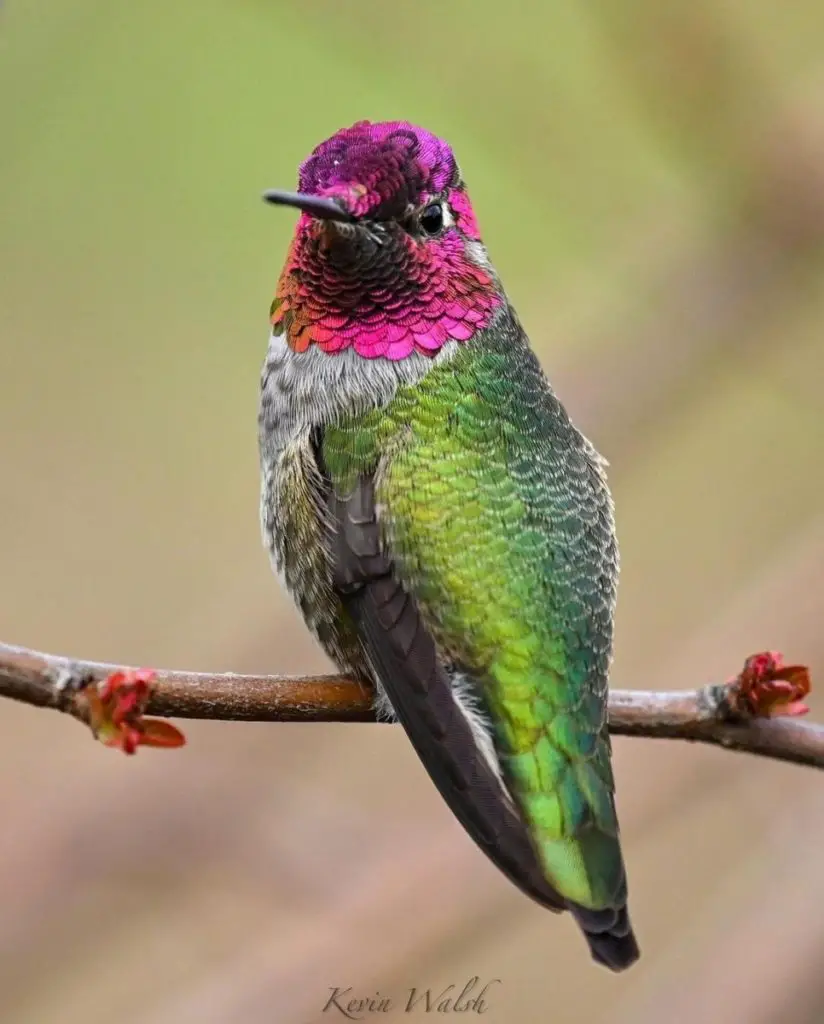
Photo by: Kevin Walsh
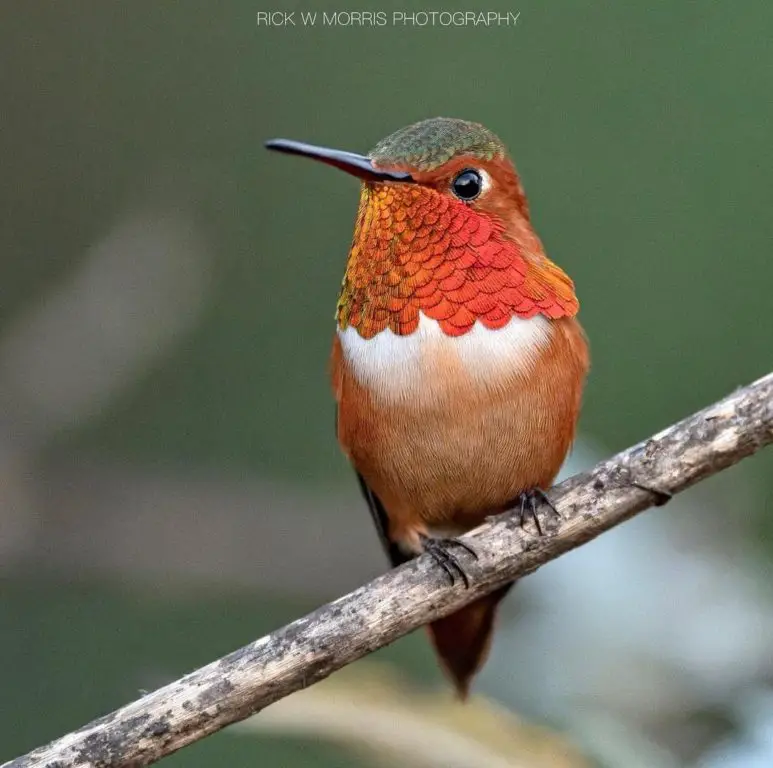
Photo by: IntheWildwithRick
Embark on a delightful journey through gardens, regional parks, or nature reserves to discover these avian treasures. I will delve into a world where one can enjoy the beauty of an iridescent royal purple band on the gorget of a Black-chinned hummingbird or be mesmerized by the bright vibrant purple cap and throat feathers extending over the crown and down the sides of the throat, resembling a pointed beard of a male Costa’s hummingbird.
Read my article:
Hummingbird Gorgets Explained: The Complete Story
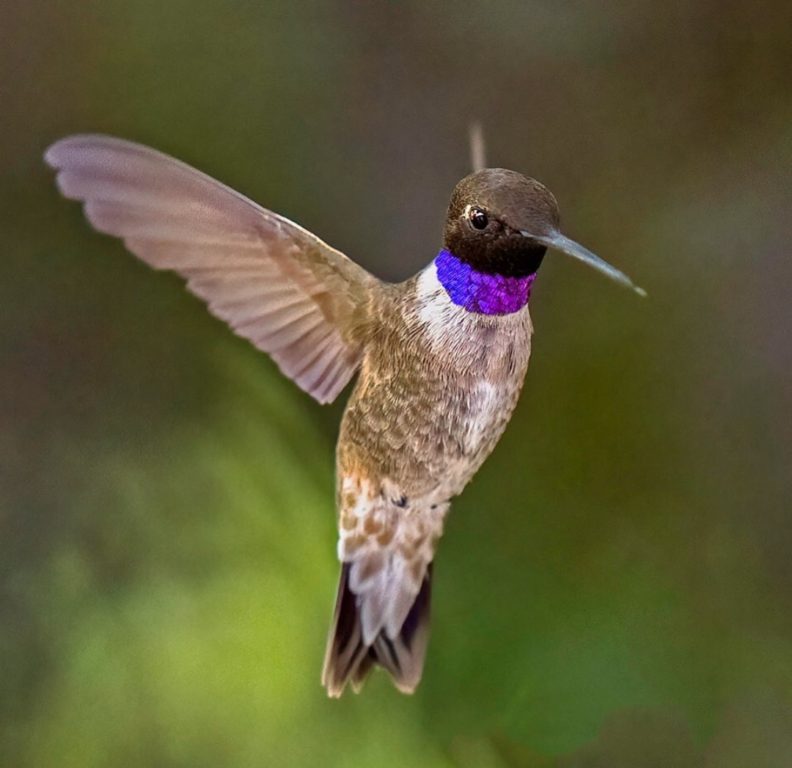
Photo by: sony_alpha_male
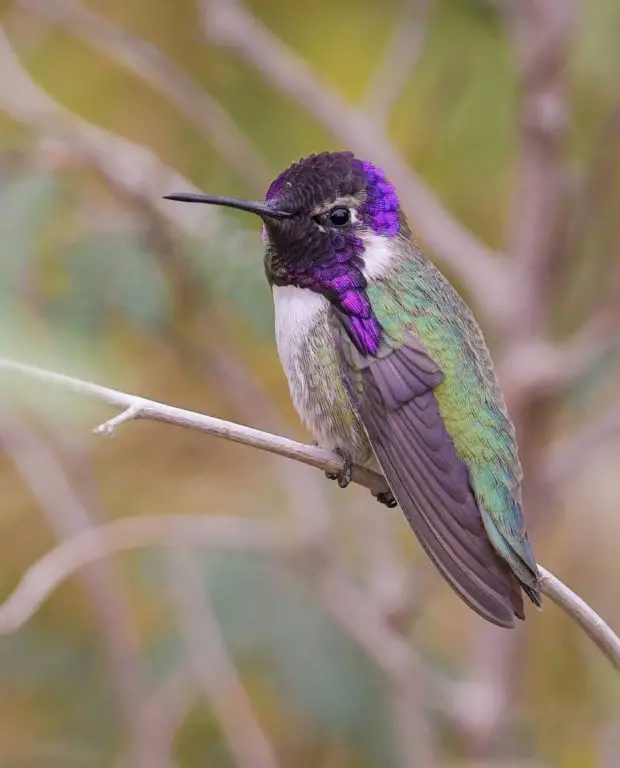
Photo by: bird.whisperer
With every sighting and every note, you will find a deeper appreciation for these bold little birds that bring such joy and wonder to our lives. Let us unfold the map of their world, an exuberant revelation of the incredible hummingbirds found in California.
Fourteen distinct species of hummingbirds are documented as being seen in California.
California-documented hummingbirds
listed in order of frequency seen:
- Anna’s
- Allen’s
- Costa’s
- Black-chinned
- Rufous
- Calliope
- Broad-billed
- Broad-tailed
- Ruby-throated
- Violet-crowned
- Rivoli’s
- Xantus’s
- Blue-throated Mountain-gem
- Mexican-violetear
For in-depth information about these fourteen documented hummingbird species found in California, including pictures of males, females, and juveniles, and where in California they are currently being documented as seen:
Read my article:
California Hummingbirds – 14 Awesome Aviators
Identifying California Hummingbirds by Sight and Sound
In the golden-hued landscapes of California, the air is often filled with the enchanting sights and sounds of hummingbirds. With a little patience and keen observation, identifying the hummingbirds found in California becomes a rewarding pastime that connects us with nature’s exquisite creations.
Whether you are gazing through your binoculars or listening in your backyard, recognizing these feathered jewels by their distinct characteristics is truly mesmerizing. Sight holds the key to distinguishing the iridescent gorget of the Anna’s hummingbird from the shimmering throat of a Costa’s. Pay close attention, as the males and females of the same species have starkly different plumages.
Read my articles:
How to Identify a Hummingbird’s Gender in 4 Easy Steps
How to Take Close-Up Pictures of Hummingbirds with Your Cell Phone
A list of California Hummingbirds by gorget color:
- Anna’s Hummingbird (Calypte anna): Males have an iridescent pink to rose-red gorget that appear almost purple in certain lights. The feathers flash brilliantly in direct sunlight.
- Ruby-throated Hummingbird (Archilochus colubris): Male gorgets are a striking iridescent ruby red, which look black in low light or from certain angles.
- Black-chinned Hummingbird (Archilochus alexandri): The male’s gorget is velvety black at the bottom, iridescent purple at the top, and is often seen as a black band with the right light reflecting the purple hue.
- Costa’s Hummingbird (Calypte costae): The male has a vibrant purple gorget that extends on the sides into long, protruding plumes that appear both purple and blue when the light hits them just right.
- Rufous Hummingbird (Selasphorus rufus): Male gorget is a bright, iridescent red-orange, appearing to glow when the sunlight reflects off it correctly.
- Allen’s Hummingbird (Selasphorus sasin): The male has an iridescent orange-red gorget, which shifts to a golden hue in certain lighting conditions.
- Calliope Hummingbird (Selasphorus calliope): The male’s gorget consists of streaked magenta rays, creating a streaked appearance rather than a solid patch.
- Broad-tailed Hummingbird (Selasphorus platycercus): Males exhibit a gorget that is a brilliant rose-red, flashing brightly when catching the sunlight.
- Blue-throated Mountain-gem (Lampornis clemenciae): The adults males have a distinct turquoise blue gorget, setting them apart from many others with red or purple gorget colors.
- Rivoli’s Hummingbird (Eugenes fulgens): Formerly known as the Magnificent Hummingbird, the male has a bright iridescent emerald green gorget that sparkles with blue or purple tones in the right lighting conditions.
- Broad-billed Hummingbird (Cynanthus latirostris): The male has a shiny blue gorget that shifts to green depending on the angle and lighting, bordered by rich black.
- Xantus’s Hummingbird (Basilinna xantusii): The male’s gorget is iridescent and glows with a vibrant green color when it catches the light.
- Mexican-Violetear Hummingbird (Colibri thalassinus): This gorget shines with a deep, vibrant violet-blue hue that covers not only the throat but also extends around the neck like a collar.
- Violet-crowned Hummingbird (Amazilia violiceps): Although not primarily noted for the gorget, the male does have a small violet to blue cap which makes for a subtle but beautiful coloration around the head.
On the auditory front, every species has its unique chatter of music. The Allen’s hummingbird, for instance, emits sharp, zeet calls in flight, a contrast to the softer lisp of the Calliope hummingbird.
Let us not forget that the vivid snapshots of a hummingbird’s mid-hover – wings frozen in a blur by a camera’s swift shutter – offers an unparalleled appreciation of their beauty, while audio recordings capture their dynamic acoustics for perpetuity.
As you immerse yourself in their world, a quintessential part of enjoying California’s hummingbirds is embracing their vivid sights and their concert of chirps, buzzes, and whirs, creating a symphony synonymous with the sunny state’s spirit.
Spotlight on Popular Species: Anna’s and Allen’s Hummingbird
As you immerse yourself in the enchanting realm where hummingbirds found in California flit and dart with seemingly endless energy, there is no denying the special allure of two of the most prevalent and captivating species: Anna’s hummingbird and Allen’s hummingbird.
The former, with its iridescent emerald feathers and ruby-red throat, is a year-round resident that definitely captures the heart of any hummingbird enthusiast. It is not just a feast for the eyes, though; the sound of an Anna’s hummingbird is equally mesmerizing, with its sharp metallic chips and whistles accentuating the California soundscape.
Then there is the charming Allen’s hummingbird—a species that exudes a similar sparkle with its brilliantly hued orange-red throat and a buzzing trill that announces its presence amongst the coastal and southern shrubs.
Both of these species embody the vibrant pulse of California’s natural wonders, allowing for endless opportunities to snap that perfect photo or to savor the simple joy of their intricate aerial dances. As an avid birder or casual observer, you will be drawn to these feathered jewels. They are the living and fluttering symbol of the state’s rich biodiversity and natural beauty.
Whether perched delicately among blooming flowers or soaring against the azure sky, Anna’s and Allen’s hummingbirds are sure to leave an indelible impression on all who are fortunate enough to witness them amidst the kaleidoscope that is California’s avian tapestry.
Discovering the Charm of the Black-chinned and Costa’s Hummingbird
As we delve deeper into the enchanting realm of hummingbirds found in California, we are swept away by the delicate splendor of two more species: the Black-chinned and Costa’s hummingbirds.
These avian wonders bring an extra dash of magic to backyards and gardens throughout the state. Perched in the sunlight, the Black-chinned hummingbird demonstrates its beauty through a velvety black throat bordered by a shimmering purple collar. It is a view that will leave you breathless, especially when catching a glimpse of their aerial displays at dusk.
The males impress with divine diving routines, aimed to woo their female counterparts amidst the soft evening glow.
See my article:
Hummingbird Dance: 5 Interpretive Explanations
Imagine being graced by the presence of a Costa’s hummingbird, whose vibrant purple cap and throat shimmer like amethyst jewels against the Californian sun.
Their distinct sounding vocal cheep merges into the soundscape, sounding a sweet note in the symphony of nature that plays in every flowering haven they visit.
Whether these hummingbirds are darting between blossoms or dancing in the sky, their charm is as undeniable as it is captivating. Their very existence adds a layer of brilliance to the diverse tapestry of life that flourishes across California’s habitats, offering endless moments of wonder to those lucky enough to witness them in their natural glory.
Exploring the Range of the Rufous and Calliope Hummingbird in California
The fascinating tapestry of hummingbirds found in California continues to enchant us as we delve into the habitats of the Rufous and Calliope hummingbirds. These two species add a vibrant splash of color and energy to California’s flora and fauna.
The Rufous hummingbird, known for its striking iridescent orange-red gorget, embarks on an incredible migration journey, tracing the Pacific coast before settling in various regions across California.
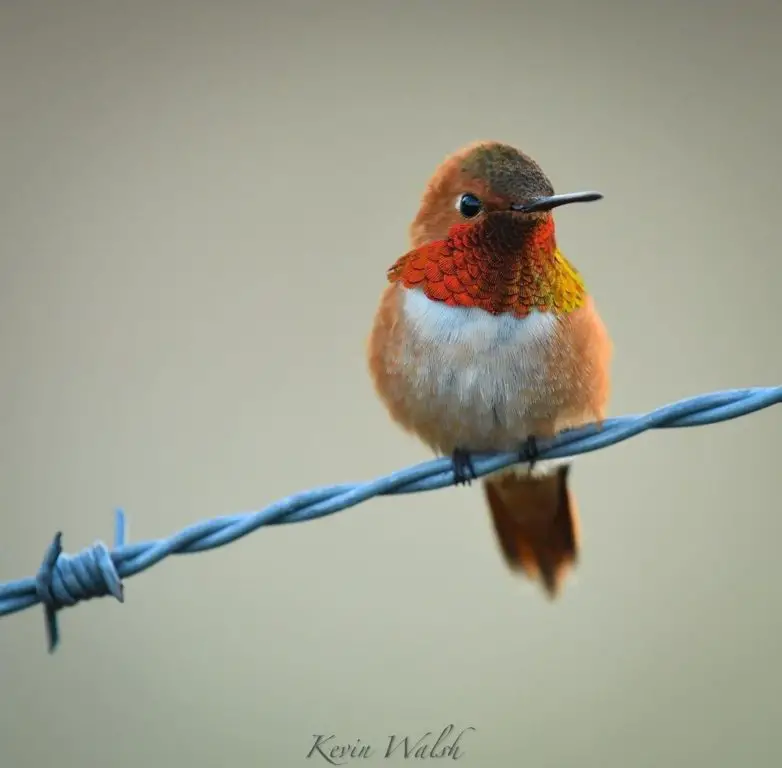
Photo by: Kevin Walsh
They thrive in open areas, gardens, and woodlands, showing a particular fondness for red, tubular flowers — a veritable symphony of sight and sound that captures the heart of every enthusiast.
In contrast, the dainty Calliope hummingbird, the smallest breeding bird in the United States, brings a subtler grace to California. These tiny marvels prefer higher elevations, particularly in the Sierra Nevada, causing hearts to flutter with their delicate iridescent plumage and lighthearted trills.
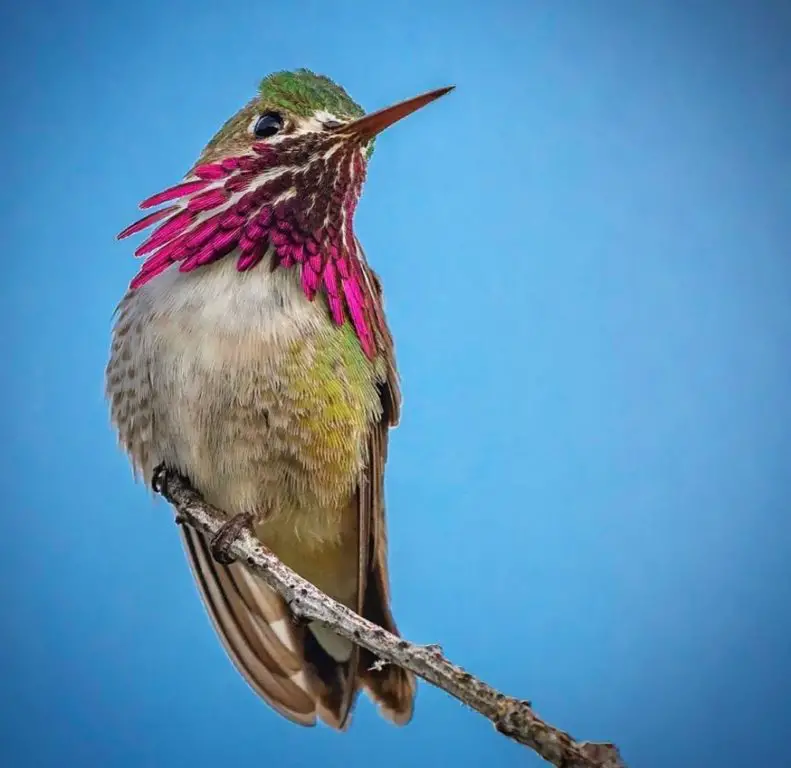
Photo by: sony_alpha_male
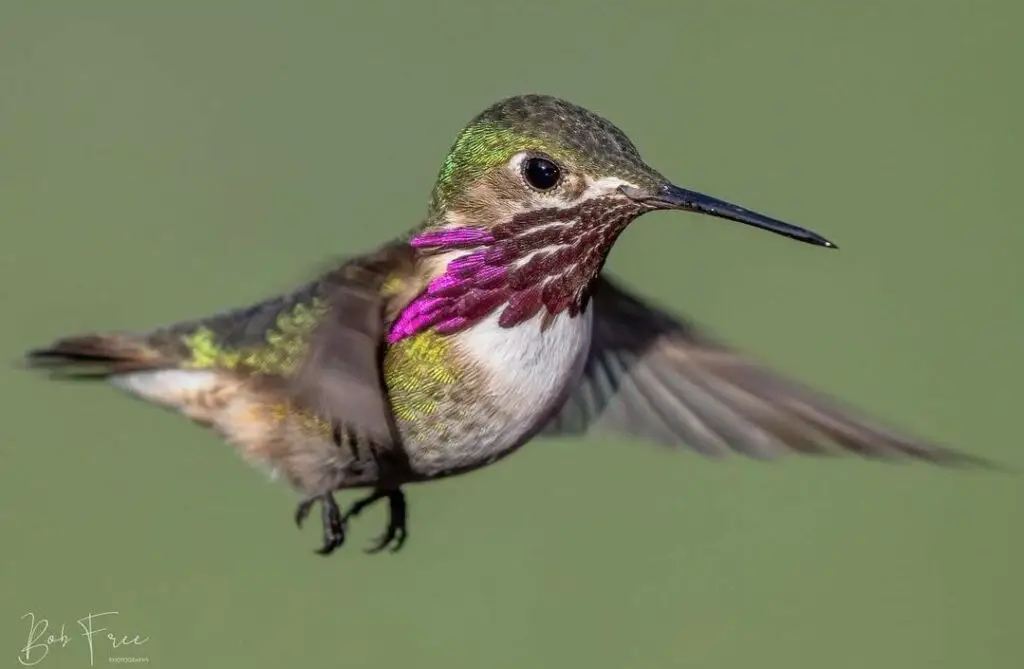
Photo by: Bob Free
As avid birdwatchers, we are continually graced with the presence of these unique species, which adorn California’s scenic backdrop with their vivacious flights and melodious chirps.
Grab your binoculars and cameras, for observing the Rufous and Calliope hummingbirds in their natural habitats is truly an unforgettable experience for those drawn to the diverse world of California hummingbirds.
Understanding the Broad-billed and Broad-tailed Hummingbird’s Habitat
As we delve deeper into the enchanting world of hummingbirds found in California, let’s turn our attention to the habitats of the Broad-billed and Broad-tailed hummingbirds.
These splendid creatures grace the Golden State with their presence, albeit in specific locales that cater to their needs. The Broad-billed hummingbird, with its striking blue throat and shimmering green plumage, favors the lush environments near the borders, occasionally venturing into the southern parts of California.
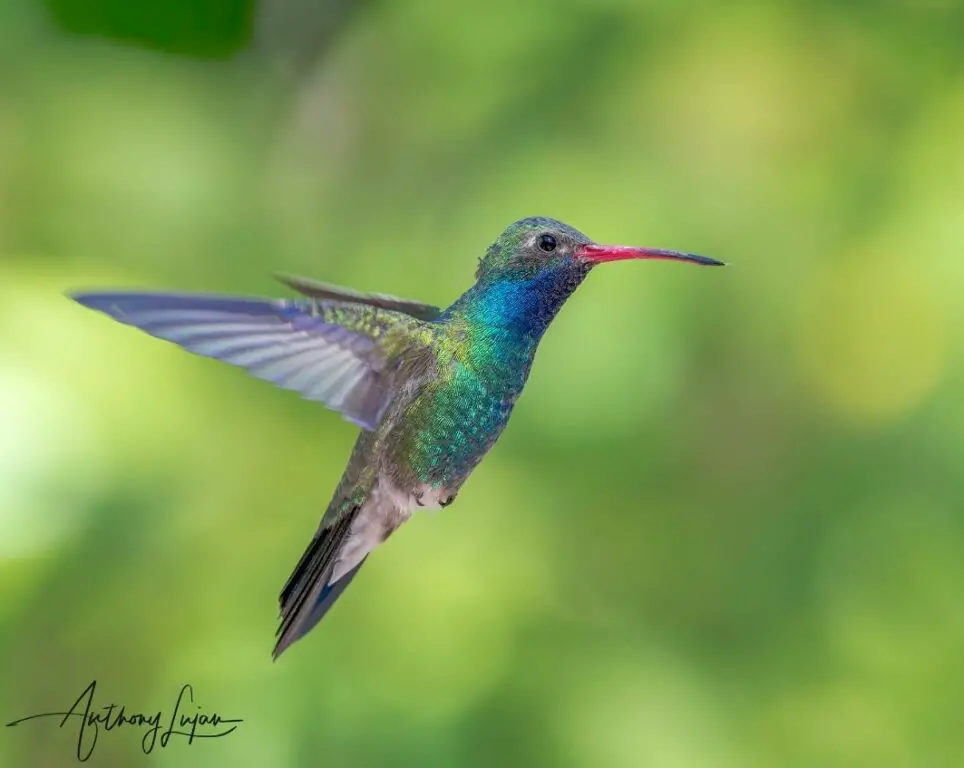
Photo by: Anthony Lujan
In contrast, the Broad-tailed hummingbird, distinguished by its rose-colored throat and high-pitched trilling sounds, most noticeable during flight displays and when hovering, has a fondness for higher elevations.
Hear the sounds of the Broad-tailed hummingbird (Cornell Lab of Ornithology link).
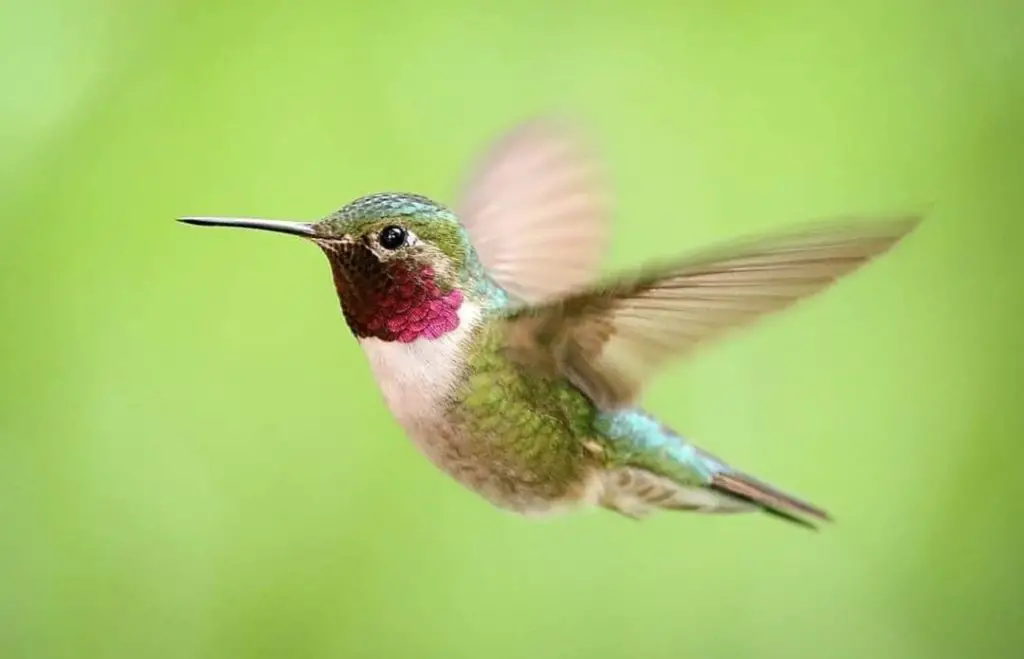
Photo by: bird.whisperer
In California, they are often found in mountainous regions, mingling with the conifers and aspens. Their habitat choice is driven by the presence of rich flower varieties and the cooler climate found at altitude.
It is fascinating to observe how each species has carved out a niche in California’s diverse ecosystem, adapting to the environments that best support their survival. Whether you are trekking through forested trails or exploring near desert blooms, keep your eyes peeled for these beautiful birds – they are a testimony to the natural mosaic that is California’s hummingbird population.
Appreciating the Less Common Species: From Mexican Violetear to Blue-Throated
Venturing beyond the familiar flashes of iridescent feathers we often see with Anna’s and Allen’s, California’s hummingbirds offer a rich tapestry of biodiversity that beckons enthusiasts and ornithologists alike.
While the deep violet-blue ear patches of a Mexican Violetear or the iridescent cobalt blue gorget of a Blue-throated Mountain-gem might be more elusive, it is these rarities that illuminate the joy of hummingbird watching. As you weave through the tapestry of California’s habitats, from sun-kissed coastlines to the whispering pines of the Sierra Nevada, there is an electric excitement in possibly glimpsing these less common avian jewels.
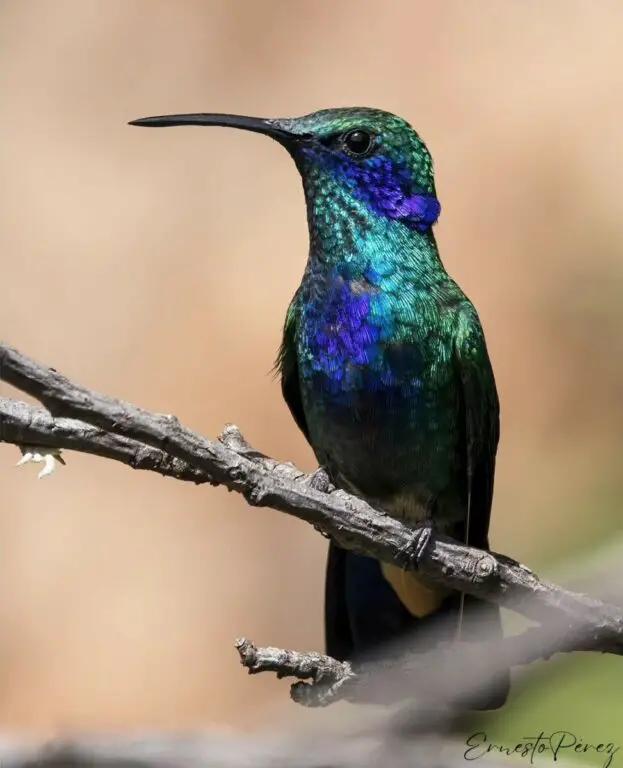
Photo by: Ernesto Perez
Hummingbirds found in California sculpt a mosaic of enchantment, a treat for those who relish in the pursuit of nature’s quieter conversations. Pictures and sounds of these species, when captured, are treasures—each click of the camera shutter and recording device, an ode to their fleeting beauty.
The Mexican Violetear, with its metallic green plumage and brilliant violet ear patches, is a visual sonnet, while the Blue-throated Mountain-gem hums a lower-pitched song that echoes its rarity.

Photo by: Rekha Pawar
These encounters remind us that even within the well-trodden paths of California’s wilderness, surprises await. With patience and a hint of luck, you may find these winged wonders enriching your outdoor forays, making every moment spent under the vast California sky a chance to witness the dance of these less common hummingbirds.
Concluding Thoughts on the Splendor of California’s Hummingbirds
Reflecting on the hummingbirds found in California, it is enthralling to embrace the sheer diversity and vibrancy these aerial acrobats bring to our backyards and wild spaces. From the buzz and blur of Anna’s and Allen’s hummingbirds to the distinctive dive of the Black-chinned and the shimmering allure of the Costa’s, each species adds a unique brushstroke to the state’s natural tapestry.
The Rufous and Calliope hummingbirds mark their presence with seasonal flair, while the Broad-billed and Broad-tailed species remind us of the adaptability of these feathered jewels. In this article, I have journeyed through various habitats, embracing the rare sightings of the Mexican Violetear and the captivating Blue-throated Mountain-gem hummingbirds—each encounter a treasure in its own right.
California’s hummingbird ensemble is a testament to the beauty and complexity of nature. They become a source of endless fascination, whether seen flitting among flower gardens or heard through their melodic symphony of sounds. Let their vivacious spirits ignite a sense of wonder in all who are lucky enough to witness them.
For more in depth information on each of these species found in California,
Read my article:
California Hummingbirds – 14 Awesome Aviators
Check out my other posts on Hummingbird Questions
Frequently Asked Questions
Q: What types of hummingbirds can I find in California?
A: California is home to a beautiful variety of hummingbirds. Some of the most common ones include the Anna’s hummingbird, Allen’s hummingbird, Black-chinned hummingbird, Costa’s hummingbird, Rufous hummingbird, and Calliope hummingbird. On rare occasions, you may spot the striking Mexican Violetear or the Blue-throated Mountain-gem hummingbird. Each species brings its own splash of color and unique charm, making California a true hummingbird haven.
Q: Where are the best places to observe hummingbirds in California?
A: You will find hummingbirds across California’s diverse landscapes, from urban gardens to natural parks. Anna’s and Allen’s hummingbirds are common in backyards and coastal areas, while the Black-chinned prefer open woodlands, especially around dusk. Costa’s hummingbirds love desert regions, and Rufous hummingbirds are often found in open areas during migration. Look for Calliope hummingbirds in higher elevations within the Sierra Nevada. Do not forget the rarer species such as the Mexican Violetear and Blue-throated Mountain-gem, which add a delightful surprise in your birdwatching adventures.
Q: When is the best time to see hummingbirds in California?
A: The best time to see hummingbirds in California varies by species. Many species such as the Anna’s hummingbird are year-round residents, while others such as the Rufous and Calliope hummingbirds are more prevalent during their migration seasons, during spring and summer. Early mornings and late afternoons are generally the best times to watch any species of hummingbirds, as they are most active during these hours.
Q: How can I tell the difference between male and female hummingbirds?
A: Male and female hummingbirds of the same species often have distinct differences in plumage. Males display more vibrant and iridescent throat colors, called gorgets, which they use to attract females. Females are usually more muted in color and may lack the glittering throat patch seen in males. Variations can be subtle, so having a field guide or using binoculars helps with correct identification.
Q: Are there any hummingbird species unique to certain parts of California?
A: Yes, some species of hummingbirds have specific ranges within California. For instance, Broad-billed hummingbirds are more common in the southern parts of the state, while Broad-tailed hummingbirds prefer higher elevation areas in the mountains. The Allen’s hummingbird is primarily found along the coast, and the Black-chinned is often seen inland. The diverse habitats of California provide unique niches for different species.
Q: How do I attract hummingbirds to my garden?
A: To attract hummingbirds to your garden, plant a variety of nectar-rich flowers such as salvia, fuchsia, and trumpet vines, which are hummingbirds’ favorites. Red, tubular flowers are particularly attractive to them. You can also hang hummingbird feeders filled with sugar water (four parts water to one part white sugar, boiled and cooled) to supplement their diet. Avoid using any pesticides or insecticides, as hummingbirds also feed on insects and spiders. Providing a water source, such as a misting fountain or a shallow bird bath, also encourages visits from these delightful birds. Patience is key—once they discover that your garden is a reliable source of food, they will return often!
Happy Hummingbird Watching!
Backyard Visitors participates in affiliate programs which compensate us for referring traffic.

